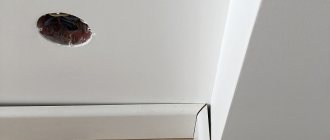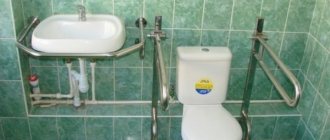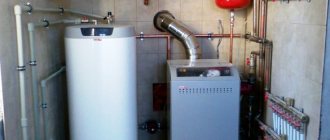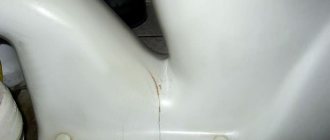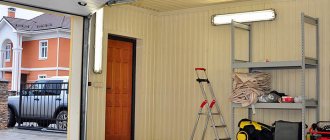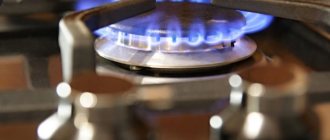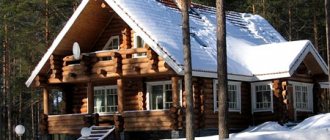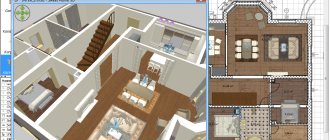Home / Heating /
For 9 years, at almost every project a builder always appears who, with a smart look, convinces the Customer to save on radiators and heat the house with heated floors. The customer has doubts and is right. At first glance, warm floors are more comfortable, but is it convenient for heating? Let's figure it out.
Good afternoon My name is Alexey Goltsov . I am a design engineer, author of articles. Heating is my main specialty. I carry out projects for country houses, shops and restaurants. 20 projects for country houses a year
I mainly design for Moscow and the region. I'm leaving for the site.
You can order a heating project from me on the “Services” .
Why did this question arise?
No matter how funny it may sound: global warming and the view of Western countries are to blame.
The design temperature for heating in Moscow is –25°C for 5 days. This temperature has not been seen for many years, and customers of private houses began to share the opinion that radiators do not work, and therefore are not needed.
Warm floors cost 3 times more than radiators. Therefore, this opinion was picked up by builders and for the last 5-7 years they have been confidently advocating to abandon radiators completely.
But there are 2 nuances in this issue that they do not take into account:
How many years are you building the house for?
My Customers often say that their neighbor’s underfloor heating works successfully. But neither the Customer nor the neighbor takes into account the period of time.
If we are talking about the short term of 3-5 years, then radiators are really not needed in this case. But the house is being built for a longer period.
In building codes, heating is considered efficient if it heats the house for 50 years. For Moscow, the minimum temperature for 30-50 years is -25°C. And even if there has not been such a temperature over the past 5 years, this does not mean that it will not happen in the coming decades.
Therefore, as a specialist, I design a combined system of radiators and heated floors. We are obliged to provide radiators as a reserve so that the house does not freeze in the cold winter.
We don't need to "heat the house"
Heating a house is an incorrect term.
The whole nuance is that we must maintain a different temperature in each room. We need to heat each room separately. In the boiler room, garage, storeroom, it is enough to maintain +15°C. In the bedroom +23°C, in the bathrooms and bathrooms +25°C.
Indeed, if we calculate the house as a single space, a warm floor for heating is quite enough, but in practice we only need to heat those rooms that border on external walls and windows.
For example, internal corridors, halls and storage rooms in a 250 m2 house are often about 50 m2, but they do not need to be heated at all.
Thermal insulation of the house
The first thing you need to pay attention to when designing is the thermal insulation of your home. And the better the thermal insulation is, the lower the heat loss coefficient will be, and therefore the less energy will be required to maintain the temperature in the room at a given level. But thermal insulation of a house is not only insulation of the walls; it is also necessary to insulate the floor, and most importantly the ceiling. You need to turn your home into a comfortable “thermos” for living. There is a good thermos that keeps the temperature for a day, but there is also a bad thermos in which the water becomes cold after 5-6 hours. Same with the house. One house will cool down in 5-6 hours, and the other will be warm in a day.
Of course, the quality of thermal insulation materials is important. They should not lose their thermal insulation properties over time. And the expression: “the more, the better” will be right on point. The larger the thermal insulation layer, the lower the heat loss coefficient, which means your home will be like a “good thermos”. For example, it will be very good if the walls of the house, floor and roof are insulated with extruded polystyrene foam 100 mm thick or other heat-insulating material at least 100 mm thick.
Windows and doors are important elements in the construction of a country house. Poor quality and poor installation can negate all efforts to insulate the room. We will talk about how to choose the right windows and doors so that they do not turn out to be a “weak link” in article 8. I will take this information from a person who has been involved in window systems for more than 20 years. This will be the expert opinion of a “window” specialist.
Is it possible to abandon radiators and heat the house only with heated floors?
From the legal side
Answer: No, you can't. If you contact a large construction company with such an idea, they will refuse you. There are 3 reasons for this:
1) The heating system is designed for the lowest temperature. For Moscow this is –25°C for 5 days. If the average temperature stays at -25°C for 5 days, no heated floors will cope. More details: SP60.13330.2016 clause 5.13.
Minimum winter temperatures in Moscow
2) The temperature of the floor surface should be no more than 26°C, and for children's institutions 23°C. This is too low a temperature to heat a room. Radiators heat up to 80°C. I will tell you further what overheating of the surface leads to. More details: SP60.13330.2016 clause 6.4.8
3) Cold convection currents always come from the window. Radiators cover 50% of the window width, which helps reduce the cold air flow from the window. More details: SP60.13330.2016 clause 6.4.4.
From a practical point of view
Answer: Yes, it is possible, but is it convenient? Unfortunately, neither customers nor builders see all the consequences. The customer relies on the experience of the builder. The builder relies on the experience of past projects. That’s why there are so many speculations and fantasies on the topic of heated floors.
I will share these consequences with you.
Selection of tools and materials
To insulate the floor you will need the following tools:
- Hammer.
- Screwdriver.
- Drill.
- Mixer.
- Aluminum trapezoidal rule 2-2.5 m.
- Aluminum level 2-2.5 m.
- Electric jigsaw.
- Caulk gun.
- Wood planer.
- Roulette.
- Knife.
- Plastic bucket with a volume of 20-25 liters.
- Pencil.
- Extruded polypropylene boards (at least 30 mm thick).
- OSB boards (at least 10 mm thick).
- Starting and finishing self-leveling floors.
- Deep-penetrating polymer waterproofing primer.
- Polyethylene (at least 100 microns).
- Drive-in dowel (at least 8x80 mm).
- Liquid nails for polystyrene foam and wooden floors.
- Plastic wedges up to 10 mm in size.
When choosing a material, the manufacturer is not as important as its quality and characteristics. You will need:
What problems do you have to face when heating underfloor heating?
The house will not warm up before your arrival
Warm floors without radiators respond very slowly to any commands and changes. His inertia is too high.
First, the system will receive a command from the boiler, then it will warm up 45 mm of concrete screed, 20 mm of floor covering, and only then it will begin to slowly release heat into the room. The floor temperature is 35°C. Therefore, to heat the house from the standby temperature of 15°C to a comfortable 23°C, the heated floor will need approximately 11 hours.
Heated floor heating rate graph
If you do not plan to live in the house 24/7, underfloor heating will be uneconomical. When you are not at home, you will have to maintain not 15°C, but 20°C, otherwise the house simply will not have time to warm up before your arrival. Radiators will heat a house from 15°C to 23°C in an average of 3 hours.
No reserve in case of extreme cold
In a combined system, radiators turn on at an outside temperature of -12°C and work together with the heated floor.
Warm floors are needed for comfort. That is why it is “warm” and not “hot”. Heating a house with underfloor heating will not work in extreme cold.
If you decide not to install radiators, you are deprived of a reserve that is guaranteed to heat the house in extreme cold. In this case, you will have to overheat the floors and run across the floor. Overheated surfaces will emit odor.
According to calculations: an overheated floor can heat a room down to -16°C. At lower temperatures, the floors will not cope and the room will be cold.
Floor covering - tiles or porcelain stoneware
Underfloor heating imposes its own limitations on the coating material. Even small carpets on the floor will have to be eliminated throughout the house, because they completely block the heat flow.
Heat transfer from the floor surface directly depends on the coating material. You won't be able to afford parquet, laminate, PVC or cork. all this is not suitable for underfloor heating systems. Laminate and parquet transfer heat 7 times worse than tiles.
Important nuance : the internal composition of the material is not so important as the surface itself! Matte and ribbed surfaces of the same porcelain stoneware transfer heat 30% worse than smooth ones.
No floor-to-ceiling stained glass windows
Stained glass windows in rooms create large heat losses. About 50% larger than ordinary windows, so heated floors are not suitable for heating a house with stained glass windows. You will have to give up façade and stained glass windows in all living rooms.
It is permissible to heat underfloor heating in rooms with 1 or 2 regular windows. If the windows are stained glass, the warm floor will not cope.
A warm floor in a room with stained glass windows can heat the room at an outside temperature of at least -12°C, which is why in Europe warm floors are used as the main heating system. This is unacceptable in Russia.
Local hot spots or furniture with legs
With underfloor heating, the only source of heat is the floor surface. In bedrooms, furniture usually consumes 40% of the space. Sofas, wardrobes and beds completely block the heat flow from the floor to the air, so heat exchange does not occur and the room is not heated.
Therefore, there are 2 options for solving this problem: – sofas, wardrobes and beds must have legs; – local overheating zones along the windows.
Local overheating zones are the area of the floor around walls and windows in which underfloor heating pipes are laid close to each other, with a reduced laying pitch, which results in an increase in heat flow.
Usually in bedrooms, the local overheating zone exactly falls on the area around the bed, so when you wake up on a frosty winter morning and get out of bed, you will definitely hit the hot zone of the heated floor with a temperature of 38-42 ° C, while without radiators the air temperature in the room will be about 18 ° C .
Characteristics of insulation
Today, the construction market is filled with all kinds of insulation and other thermal insulation systems that allow you to retain and maintain heat in your home. All of them are intended for different parts of the building, and can also perform different functions. Pay attention to all the features inherent in each type to choose the one you need. If you are going to do everything yourself, then we advise you to choose a good insulation option. You will save on labor, but you can spend money on material, then you will feel comfortable in the house, regardless of the time of year.
Choosing floor insulation
Before you start arranging your floors, we advise you to carefully study the existing materials that allow you to insulate your home. Each insulation system contains different materials and can only be installed in specific rooms. Compare all the advantages and disadvantages of each type to choose the best one for yourself, then the home will fully retain the warmth that is so lacking in winter.
The following materials are used as floor insulation:
- Vermiculite. To make this material, two types of dark mica - biotite and phlogopite - are first mixed. After this, they are mixed with liquid glass and carbonate filler, and then pressed. By weathering the resulting product, recycled minerals are obtained. They are subsequently burned to produce vermiculite, which has excellent environmental performance. In addition, such insulation is absolutely harmless to the human body. It is produced both in a piece version with a plate thickness of 200-600 mm, and in powder and liquid form.
This insulation has a dense structure because it has closed microscopic cavities. This allows you to get rid of the accumulation of condensate, thereby increasing its service life. Vermiculite has very high thermal insulation properties, but it is worth considering the following - this material is quite expensive. The use of this thermal insulation material is beyond the means of a person with average income. - Mineral wool. The occurrence of convection in such a material is practically excluded, since microscopic cavities do not allow air to pass through completely, and therefore mineral wool has low heat transfer rates. This insulation is much cheaper than the previous one, but no worse. It has one more feature - when laid vertically, the material can slide, losing its useful properties. It is better to use this material on horizontal surfaces, or worry about additional fixation of cotton wool in advance.
There is also an aluminized version of mineral wool. The mat is covered on one or both sides with a special aluminum or metallized coating. This slightly increases the cost of the insulation, but greatly increases its useful properties. If installed correctly, such material does not require a vapor barrier layer, and you can completely forget about the dew point. If there are two layers of aluminum foil, the temperature regime in the mineral wool is equalized. This is due to the fact that each layer of film forms a heat shield effect. The minimum thickness of aluminized mineral wool is 6 mm, which is significantly less than the usual option. Please note that it is better to work with this material wearing safety glasses, a respirator and gloves, since the microneedles contained in the insulation can enter the respiratory system and mucous membrane, which is extremely unacceptable. - Styrofoam. The material is perfect for insulating floors along joists. It has a continuous dense structure, which eliminates convection. In addition, foam plastic is environmentally friendly, and condensation does not form on such a coating. It is also important to note that this insulation is very cheap and harmless, but it also has its drawbacks. Polystyrene foam is a fragile material because it is easily subject to mechanical stress. In addition, movement of the dew point inside buildings made of aerated concrete and shell rock is most likely, since foam plastic does not fully cope with this task. This material is perfect for arranging a wooden floor in a dry room, but requires mandatory finishing with decorative flooring.
- Expanded clay. The material consists of round-shaped pieces of clay with the addition of aluminosilicate filler, which are fired. Expanded clay is more often used for insulation under screeds, since it has a fairly low cost, while being strong and durable. The advantages of this insulation also include: environmental friendliness and poor thermal conductivity. But it is also worth mentioning that expanded clay pellets have high hygroscopicity, absorbing up to 20% of moisture, and this already indicates the disadvantages of this material. Before installing a floor using this insulation, take care of high-quality vapor barrier.
- Organic insulation. Sold both individually and in rolls. In order to make the material, flax and jute fibers are used, due to which such insulation is often called fibrous. It is most often used as a lining under laminate. But keep in mind that the natural version of insulation may begin to rot from moisture, while the synthetic version may deteriorate over time. But they are convenient and fast to work with, and besides, it has properties similar to mineral wool.
- Polyurethane foam. An excellent way to insulate a floor, requiring special professional equipment, since it involves the use of the spraying method. The insulation is a liquid similar in composition to polyurethane foam, which is sprayed onto the coating. The main disadvantages are considered to be: high cost and subsequent expensive finishing.
- Bulk insulation. It is a dry or liquid mixture that can be poured onto the floor without additional preparation. The solution has a very high cost because it is difficult to manufacture. This material is more suitable for insulating floors in expensive mansions or high-class hotels.
- Granular concrete. It is a mixture of cement-sand mortar with granular filler (expanded clay, polystyrene foam, vermiculite, stone chips, etc.). The insulation method is quite simple and cheap, due to the low cost of the material. But the heat-insulating properties and strength indicators are much higher than, for example, foam concrete. Often used to insulate the top layer of a two-layer screed for floors under which the basement is located.
As you can see, the list of materials that can be used to insulate a room is quite long. All of them will perform their useful function to one degree or another, it all depends on where you will use them. Compare the features of each type with the location of the future insulation, then the coating will last a long time, and winter will not seem so cold to you.
When can you heat a house without radiators?
For this article, I analyzed the heating calculations of 20 cottages. For Moscow, the heating system is calculated according to standards for –25°C, St. Petersburg –24°C, Kazan –31°C, and only in the Krasnodar and Stavropol Territories, Rostov-on-Don and Crimea can it be heated with heated floors without radiators.
You can heat your house with underfloor heating when the outside temperature is not lower than -18°C.
Special construction region. Krasnodar region, Stavropol region, Rostov-on-Don and Crimea.
You do not plan to live in the house in winter. In the fall, you drain the water supply system and heated floors and close the house until spring.
Additional heat sources. Do you have a fireplace, stove or electric heaters?
Building with temporary use. Garage, covered gazebo, separate bathhouse. There is no point in maintaining a temperature of +23°C. In the most extreme cold, you will not be in the building, and the standby temperature of +15°C is sufficient. Warm floors will do.
Heat pump. Heating with heated floors is recommended by sellers of heat pumps. The heat pump does not prepare water at 80 °C - as needed for heating, but only 55 °C, which is optimal for a heated floor system. Radiators on water at 55°C will turn out to be huge.
Types of heated floors
Warm floor is used:
- for heating a cottage or house without radiators, it is also possible to combine it with radiators;
- for heating floor coverings made of ceramic tiles or other materials and providing a comfortable feeling for human feet.
Warm floors, based on this, happen:
- water;
- electric.
Now we will talk about water underfloor heating systems and their component - insulation for water heated floors. Let us also consider with calculations the effect of insulation on heat loss.
How much underfloor heating is needed for heating?
The issue of heating a house only with warm floors needs to be worked out at the stage of the architectural project. Rooms with stained glass windows cannot be heated with underfloor heating alone; radiators are required. But rooms with conventional glazing are quite suitable for underfloor heating.
To heat rooms only with heated floors, you need to deliberately increase the free area of such rooms.
We know that 40% of the area is occupied by furniture, so we need to compensate for the missing space by combining rooms with adjacent rooms: combining a bedroom with a dressing room, moving the door to the corridor.
The formula for any type of house looks like this:
Spom – room area in m2 For a room with 1 window and a window sill Spom x 0.69 (69% of the floor) For a room with 2 windows on different facades Spom x 0.79 (79% of the floor)
For example , for a bedroom of 21 m2 with 2 windows, the required heated floor area is 21 × 0.79 = 16.6 m2. Furniture occupies 40% of the area, which is 0.4 x 21 = 8.4 m2. To heat such a bedroom with a warm floor, we need to increase the floor area by 16.6 - (21-8.4) = 4 m2. As a result, we need to expand the room by 1 m2 and add a dressing room of 3 m2.
Using this formula, you must first calculate the total area of all bedrooms, and only then adjust the area of the remaining rooms.
How to make floors in a private house and fill them so that they are warm?
Insulating the floor in a private house is not an easy task. If in multi-storey buildings the floors are insulated at the expense of the lower floor, then in a private house the situation is exactly the opposite. Cold air emanates from the ground, which makes the task of owners of private houses much more difficult. Therefore, owners of private houses pay special attention to the issue of floor insulation in their homes.
Of course, modern technology has solved this problem, and in more ways than one. There are three types of floor insulation in private homes:
- insulated screed;
- insulated wooden flooring;
- various floor heating systems.
Which is better: heated floors or radiators?
For heating in autumn and spring - warm floor. In winter - radiators. Warm floors are a low-temperature system and respond slowly to weather changes.
In spring and autumn, the temperature difference between inside and outside the house is not as significant as in winter. Therefore, warm floors during this period, despite their slowness, are much better than radiators.
But in winter the picture is the opposite. In the house +23°C, outside -15°C. The temperature difference is huge. The cold flow from windows and stained glass penetrates into the room much more intensely than in autumn or spring. We need to stop these flows. Nothing can be better than radiators or convectors built into the floor.
Which system is better
Any choice should be based on knowledge, so let’s make a small comparison.
- The battery sections practically do not fit into the interior.
- They heat the walls, while the heated floor is exclusively the air in the room.
- The installation of heated floors requires significant costs, both labor and financial.
- In rooms heated by underfloor heating, you can lower the temperature a couple of degrees without reducing the level of comfort.
- These floors are distinguished by increased thermal inertia. It takes from a couple to 24 hours to warm them up, however, the cooling cycle takes no less time.
- Operating heated floors is overall cheaper than operating radiators.
On a note
Thus, the conclusion suggests itself - in the future, in most cases, heated floors will be installed instead of radiators. And don’t let the initial costs scare you – they will definitely pay off over time.
Analysis of misconceptions
Uniform heating with heated floors. The temperature in the legs is higher, above the head – lower, and this is good, because... evenly and physiologically. Complete nonsense! Our task is to ensure not uniform, but rather local heating of the room in the areas of windows, external walls, corners, and street doors. We need to stop the cold currents from these surfaces.
Cost-effectiveness of heated floors?! How can a system that responds slowly to change be economical? The room became hot - and the warm floor will reduce power only after a couple of hours. Where are the savings?
Warm floors for allergy sufferers are complete nonsense! The phenomenon of “dry sublimation of dust” begins at temperatures above 90°C. The smell of dust from radiators comes only because they generally forget to wash them. In this case it has nothing to do with temperature.
Warm floors retain moisture. In winter, the air outside is dry by itself: 0.39 g/kg. In summer – wet – 10g/kg. Air humidity does not depend on the temperature of heated floors or radiators.
If there are misconceptions that I missed, write to me, we’ll discuss them and add them to the article.
Ceramic tile
Second rule
All areas with ceramic tiles must be heated.
This is due to the high thermal conductivity of the tile itself. If you put your hand on any board in your apartment, it will seem a little warm to you.
And if you place your palm against the metal door of a refrigerator or an unheated oven, you will feel a certain coolness.
However, their temperature will be absolutely the same - room temperature. Iron things always seem much cooler because they have higher thermal conductivity. That is, they transfer their temperature to your hand faster.
Thus, we exchange temperature with any object we come into contact with. However, you can warm up small objects and things - watches, clothes, a chain with your body, but you will never be able to warm up a layer of concrete with tiles.
On the one hand, the coolness from ceramic tiles seems slightly pleasant, but it all ends in illness.
Another important point is the following. Tiles are mainly laid not because they will last a long time, but because of their moisture resistance.
For example, it is placed in the hallway. Come in from the street with wet shoes and immediately put them on the tiles.
It's hard to imagine a bathroom without tiles on the floor. At the same time, you can safely spill water in it, without fear of subsequent swelling of this floor.
However, after you spill this water, you still have to clean it up. And in order to dry the bathroom, it is not enough to simply turn on the exhaust fan.
It also needs to be warmed up so that over time mold fungus does not grow on the walls.
Therefore, if you want to maintain your health and also use your finished floor for a long time without repairing it, be sure to think about forced heating.
Advantages of radiators
1. Installed under the windows . Windows are a source of rapid heat loss. The temperature outside changes all the time, which leads either to an increase in the cold flow from the window or to its decrease. The radiator smoothes out these flows.
2. No requirements for premises. Over the years, you can replace tiles with parquet, lay carpets, install monolithic furniture and not depend on the requirements for heated floors.
3. No overheating areas that are uncomfortable to walk on.
4. No odors from furniture or carpets. Warm floors heat up the furniture. There is a smell coming from the furniture.
Heating options without batteries
Today there are several types of heated floors, each of which has its own pros and cons. The feasibility of installing each type as the main heating depends on the parameters of the room and the planned heat source.
Water floor
To operate this type of heating, you need a boiler that heats the coolant and a pump that circulates water through the pipeline. Installation of a water floor is very complicated and requires laying several layers of material (thermal insulation, reinforcing mesh, concrete screed, finishing coating). Both independent and additional heating can be used for rooms of any size, however, for large houses it will be necessary to carry out complex calculations and install one or more collectors.
Cable floor
Cable-type electric heaters occupy part of the floor area (about 70%), they are placed in places free from furniture and heavy objects. It is usually used for independent heating of small rooms or as an additional one, since heating a large house with electricity is not economically profitable.
Infrared film floor
Suitable for small and medium-sized rooms and does not require laying a cement screed, so it is advisable to install IR film not only on the floor, but also on the walls and ceiling. This type of heating can be used as the main one, provided there is a stable power supply.
Rod electric floor
A deck made of interconnected carbon rods is laid under a concrete screed or tile and provides the most effective distribution of heat emitted in the infrared range. This type can be rationally used for heating individual rooms or small spaces.
Read more about choosing a heated floor and designing the system in our articles.
Conclusion
Each house is too individual to promise anything without calculations. It is possible to heat a house with underfloor heating, but this issue needs to be discussed at the stage of the architectural project.
Combine bedrooms with a dressing room, increase the area of the rooms due to corridors and moving doors. Conceptually, you need to think through each room separately.
A house without a project is just “savings”.
If you find a company that easily answers this question, I advise you to doubt the competence of these people. The issue is complex and requires a thoughtful approach.
If you don’t have time to experiment with the heating system, or don’t have extra money for constant improvements, I recommend calculating the heat loss of the building, or better yet, designing a heating system and heated floors.
You can order a project from me in the “Services” . Based on calculations, we will be able to select the right radiators, pipes and find out the exact cost of equipment and installation work. We will be able to understand which rooms can be heated with underfloor heating and what architectural modifications are needed for this.
Preliminary project cost calculator
Thanks for reading! For the design of engineering systems, please call or email [email protected]
You might be interested in:
How to choose a design company? Guide for the Customer What is included in the design cost? 10 reasons to work with us
Comments
- Leonid:
06/01/2020 at 17:23In practice, 3 houses are fully heated with underfloor heating, everyone is happy. You have too many pros and cons.
Answer
- Goltsov Alexey:
02.06.2020 at 15:57
Leonid, Good afternoon. Thank you for your attention. An excellent phrase: “In practice, 3 houses are completely heated with underfloor heating.”
1) What do you mean heated? At what temperature? At -10°C - is it “heated”? and at -25°C? Professionals don't talk like that. According to the standards, “houses are heated” at -25°C for 5 days for Moscow. This temperature has not been seen for a long time. I suspect that you are misleading me.
2) What does completely mean? — My sofa is near the window, the guests are sitting with their backs to the window. In the morning they complain - “the back is blown.” Is it complete or not complete? or is the guest to blame? or is the owner a fool? And the Code of Rules SP 60.13330.2016 - are we violating because we come up with our own rules? Is that how it works?
3) The house will be warmed up with warm floors from 12 degrees to 23 for 11 hours. This is a minus that outweighs all the pluses.
Answer
- Alexander:
01/18/2021 at 10:06
I will be very surprised if my post gets approval)) But the author must be able to admit his mistakes.
Answer
- Goltsov Alexey:
01/18/2021 at 14:38
Alexander, Good afternoon. There is no need to treat people as idiots. I really won't post your messages with an advertising link.
You are involved in heat pumps. Radiators don't work with a heat pump, so you're left with underfloor heating. Your income and the well-being of you and your family depend on it.
For my readers: - Alexander wrote that heated floors are 20-30% cheaper than radiators. — Local overheating zones are not dangerous. I didn’t specify what exactly is not scary. — Stained glass windows and heated floors are combined within reasonable limits. He did not specify where reasonable limits begin and end. — Sent the video to my resource
Answer
- Ulvi:
04/25/2021 at 21:00
I don’t even know what to say, but I was working in such an office, sitting all day in a huge room of 150 square meters, even more, and there was only a warm floor. It was very hot, even stuffy in winter. But in our street the maximum temperature is -2
Answer
- Goltsov Alexey:
04/26/2021 at 13:23
Ulvi, the floor area of an office space is much larger than the area of the external walls and windows; if you have a single room of 150 m2, then underfloor heating is possible. My article about underfloor heating for private homes.
Answer
Design
The design of these systems is not an easy process and quite responsible. It requires careful compliance with SNiP, so their installation begins with the development of the project.
On a note
We must not forget that any mistake made at the design stage can only be corrected by opening the screed.
The purpose of the design is to determine:
- necessary materials for water heated floors, correctly calculate their quantity;
- components for water heated floors: pump, controller, pipes, etc.
To ensure the required efficiency of heated floors, their operational reliability should take into account many subtleties, including:
- height, shape and area of the heated room;
- optimal temperature;
- features of heating elements, etc.
When calculating, it is taken into account that
- The optimal diameter of the main pipes. Usually it is 16-20 mm.
- Water temperature after mixing. It can range from 54 to 55°C.
- Calculation of the number and parameters of control nodes - collectors.
After this work, a general layout of the mains is drawn up, into which the floors are divided, expansion joints, and connecting them to the collectors.
On a note
At the same time, pay attention to the fact that when laying out the contour, the pipeline lines do not have points of intersection with the deformation space.
You can calculate the system yourself or use programs specially created for this. True, this requires certain rules, so when installing it yourself, it is recommended to take as a basis ready-made factory layout diagrams of pipeline circuits and an installation plan.
Recommended Powers
Specific and linear power depending on the type of room.
A warm electric floor as the main heating copes with its task if it has the appropriate power. The calculation depends on the type of heating element:
- The heating cable parameter is linear power. On average it is 18 W/m. Knowing the value, it is easy to calculate how much cable is needed to heat 1 square meter. m.
- The indicator for a cable mat is power density. They produce products with a power of 150 W per 1 sq. m. Modifications with a power of 200 W are less common.
- Infrared films are more powerful - from 130 to 230 W/sq. m. They are more often used as the main heater.
- Rod mats produce power from 130 to 160 W per 1 sq. m.
The indicator is selected based on the purpose. In living rooms, floor heating with a power of 120 to 180 W/sq.m. is required for basic heating. m, for the bathroom – 120–150 W/sq. m, for a loggia - up to 230 W/sq. m.
Concrete floor in a private house
The easiest and cheapest way to make a floor is to fill its surface with screed. A mixture of sand and cement is much cheaper than other building materials, but this type of floor has the biggest drawback - the cold emanates from it. In winter, it is absolutely impossible to walk on a concrete screed without slippers. But today modern technologies have solved this problem. Insulation is placed under the screed layer, which, although a little, solves this problem. Expanded clay, granulated slag and polystyrene are suitable as insulation materials. Modern craftsmen generally give preference to foam plastic.
The cross-sectional structure of our concrete screed will resemble a pie that has several layers. First, foam plastic is laid on the floor surface for insulation, and then the screed is poured. The process of pouring a concrete screed occurs in approximately five stages:
- The first stage is surface waterproofing. It is best to lay special waterproofing materials on the ground to prevent the appearance of mold and various fungi. A suitable material for this task is thick polyethylene film, which is laid directly on the soil surface. But it is best to use a special waterproof barrier, which is made of bitumen mastic;
- The second stage is gluing porous material made of foam vinyl along the entire perimeter along the walls at a height of up to 15 cm. This material ensures the plasticity of the foam during temperature changes and protects it from cracking;
- The third stage is laying the foam itself. The foams should lie tightly to each other. If the concrete solution gets into the resulting cracks, then cold can penetrate from there, which makes our work completely useless. Therefore, the cracks that appear are filled with polyurethane foam;
- The fourth stage is the reinforcement of the screed. A concrete screed without foam reinforcement will not last even one year. A few months are enough for the concrete screed to begin to crack, and not even one year will pass before it simply falls apart. Therefore, reinforcement can be said to be a prerequisite;
- The fifth stage is the screed itself. After the reinforcement stage, the concrete solution itself is poured. The thickness of the concrete screed must exceed 50 mm. The concrete solution must be stronger than required, that is, the usual ratio of 1:4 is not suitable, it is better to use a ratio of 1:3. Also, to avoid cracking of the screed, plasticizers are added to the concrete solution.
The process of insulating a concrete screed goes something like this. Although concrete screed is the cheapest and most affordable type of flooring, it is not enough to make your home cozy and comfortable. To do this, they also resort to various heating systems.
Wooden floor heating system in a private house
Heating a wooden floor does not require much effort, since wood is a warm material that does not require additional heating. The only thing that can be done is to increase its efficiency through additional heating systems. But by laying insulation, we can deprive our floor of normal ventilation, causing the wooden material to deform. Therefore, you need to calculate the waterproofing system and the more carefully you think through everything, the better.
To insulate a wooden floor, it is enough to lay mineral insulation under the flooring. It is not recommended to use polystyrene foam, as it does not allow air to pass through. And as a result, the natural ventilation of the room is disrupted. All that can be done in this case is to leave space between the wooden flooring and the insulation. A space of 50 mm will be sufficient so that natural ventilation is not disturbed.
